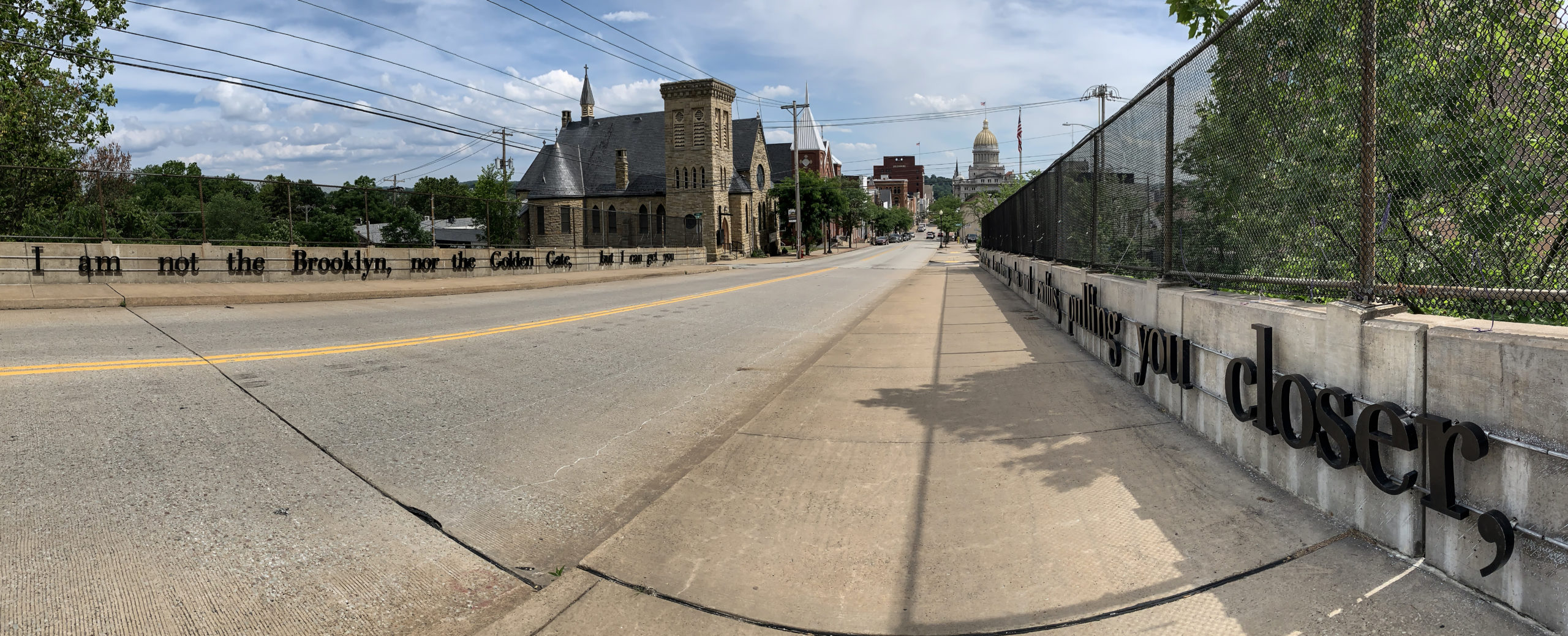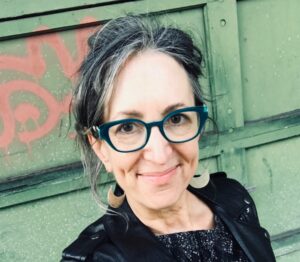
Bridging the Gap: A Public Art Project
About the Artwork: Analog Scroll
Janet Zweig’s Analog Scroll considers how The Westmoreland Museum of American Art interacts with and connects to the community of Greensburg. A 10-year project involving ten Southwestern Pennsylvania poets, this site-specific artwork activates the North Main Street bridge that connects the Museum with downtown Greensburg. Each poem is displayed line by line, changing periodically until the poem is completed and the next one begins.
Now Featuring: “BRIDGE BIRDS OF LEAST CONCERN*” by Joy Katz
*The International Union for Conservation of Nature (IUCN) classification of least concern means an animal is thriving. There are lots of these four birds near the bridge. They are in no danger of extinction.
oo LEEE ooo ooo oo LEEE ooo
Small ball head. Pretty invisible, blends in, but: pink feet. Despite name, not sad.
AW aw aw AW aw aw aw
Fighting machine of black suede and black silk. Likes trash, jokes, a big party.
BEE yip bee! yip bee! yip
Decapitator. Nest raider. Still, yay for azure, its color: so crazy in winter.
CHACK chack chack chack
Dressed like football ref. Hair: flamin hot cheeto. Pulls bugs from dead trees, eats.
About the Poet: Joy Katz

Joy Katz is a poet, social practice artist, and essayist. She lives in Pittsburgh, where she also collaborates in the artist collective IfYouReallyLoveMe and teaches off the tenure track in Carlow University’s long-running Madwomen in the Attic workshops. She is an editor at large forCopper Nickel.
About the Artist: Janet Zweig
Janet Zweig has been working in the public art realm for over 23 years. She has designed public art installations for the City of Milwaukee, St. Louis, Kansas City and New York. Locally, she has successfully collaborated with LaQuatra Bonci Associates Landscape Architecture to build a memorial in the lawn of Pittsburgh’s Mellon Park. In 2018, Janet Zweig’s Analog Scroll was recognized by the Public Art Network (PAN) Advisory Council in their 2018 PAN Year in Review Trends and Themes: Site Responsive Projects.
About the Project: Bridging the Gap
The Westmoreland Museum of American Art and the City of Greensburg have partnered on Bridging the Gap, a public art project to revitalize the North Main Street bridge that connects The Westmoreland to downtown Greensburg. Working with Pittsburgh’s Office of Public Art, a selection panel of local residents, Museum staff, and representatives of the City and PennDOT considered dozens of artists for the commission. In the end, Janet Zweig’s installation Analog Scroll was selected. Funding for the project was provided in part from a National Endowment for the Arts Our Town grant program award, The Heinz Endowments, Westmoreland County Tourism Grant Program, Community Foundation of Westmoreland County/Revitalizing Westmoreland, Rivers of Steel National Heritage Area, Carol R. Brown, The Tomahawk Hill Foundation and supporters of an Indiegogo campaign hosted by the Museum. Throughout the project, technical support has been provided by the Office of Public Art, Pittsburgh.
Click through to read the full press release and view a featured article and video from TribLive about the project.
Featured Writings
Upcoming Writers to Be Featured
- Karen Dietrich, 2025-2026
Previous Featured Writers & Works
Nexus
by Sarah Williams-Devereux
What this bridge must carry: concrete, rebar, its own careful weight,
light enough to rise, strong enough to bear our bodies across,
we people of great hills and strong calves and lightning strikes and broken chains,
our etched portraits and flower baskets, our quaking greens and numbered schedules,
the gold corn bushels and soft coal buckets we dig from the earth,
the live weight of our grieving, solid feet.
How can we make these burdens softer for one another,
transform this dead weight into living light?
Our struggle: tension and compression, gravity and history, erosion and truth,
Us at one end, Them at the other, the invisible center rising between,
trapping us for a moment in our blind spots.
And isn’t that what matters, to trust in our steps,
always moving toward each other, toward a nexus we cannot see, only feel,
knowing we can be in the same place at the same time?
Let us gather in reverence, in gratitude,
bring offerings of whiskey and incense, maple and milkweed:
to dark valleys and wide rivers, to all the empty, shattered spaces,
thank you for teaching us the meaning of separation;
to those who set these piers and girders
with blood and bone and bruised, brave hands,
thank you for teaching us the meaning of connection,
for granting us safe passage across plateaus older than thought,
Fulcrum
by Fred Shaw
I am not the Brooklyn, nor the Golden Gate, but I can get you
there from here. I am a forearm, ulna and radius, pulling you closer,
like a handshake or a hug. My cement holds the sweat of labor, the curse words
of one foreman, a bubble of air trapped among the aggregate of sand and stone,
a breath from another time and place. In the dark, I can hear the hiss of taggers
bombing the gray spaces below, leaving their pastel fingerprints all over
what’s hard and blank beside the rails and ties. My steel girders and seams allow
the rolling whisper of tires. I never tire of those bass lines rumbling
from car trunks or the titter of hand holding lovers walking up and down my vertebrae.
Bounded by sumac going red in fall and smelling like wet dog
by early summer, I watch the seasons change, see clouds as my inverse drifting overhead,
wait to be warmed by a shower of rays or cooled by the hard rains tumble.
All day, I counter gravity forget my fear of heights or change
while bordered by church, school and row office filling the gap
between the have and the not that crisscross these hills.
I am a homely ribbon pinned atop the beating heart of this place, waiting
on you to downshift to slow for traffic to take a deep breath
before my steep grade amidst the choking exhaust of a big rig ready to unload.
I am forgotten in the form of locks of love an empty beer bottle
a piece of buttered bread dropped and drying on the table of my back.
And though I offer no parking at any time and have no busking horn player to greet you
remember me as essential a fulcrum a steppingstone
where you can forget about torsion and shear instead letting me lever you toward
thoughts of something bright and warm what awaits you after the last bend for home
Find out more about the poet Fred Shaw, his work, and more in this blog post.
Mile Marker 322
by Michelle Stoner
Start with the flowers: hostas, lilac,
firework of the bright hydrangea.
Move to the lichen, greenblue
on stone, ancient, and wonder
what will remain of now, be lost.
Which piece will you miss most
when it is gone, emptied like coal
cars, rusted, running under this bridge,
grey area, mechanism, a link.
Metaphors are like passenger trains,
bridging the gap between east and
west, moss and fence, and you.
From up the hill to the crinoline ball
to down the street where skin is rubbed raw,
you are all these things: stardust and lock
on the chainlink for love, sycamore bark.
You are the woman in traffic behind you singing,
birds alighting to the top of the courthouse dome,
groundwater seeping up from the shale
of this cliffside sheared and crumbling
to the shining steel tracks below. You are
the momentary bones of these mountains,
dateless, but still impermanent. So think now
of what you love about water, before it goes dry.
Main Street Bridge, Greensburg
by Jan Beatty
It’s not the elm and wild cherry
that rim the bridge on Main St, not
the double railroad tracks in the streambed,
the 30 ft boulders half-embedded in the massive
hillside—it’s the breeze you feel on the way up
the bridge walk, past the concrete and girders,
the tall chain-link. On a Monday at noon, you can
feel the whoosh of 10 trucks rolling past in
three minutes, the Mack hauling a front loader,
shaking the bottom as it rolls over Tunnel Street,
the independent contractors on the job: plumbers,
builders, pipe-haulers. What breeze is this? It’s
the hill, the walk up to Academy Hill, the museum
and Cultural District—Get Into It, the banners say!
In these relentless green spaces of the Sewickley
watershed, the slate streambed is sometimes
dry. But what keeps driving are the bodies:
people walking this concrete bridge, the woman
in lemon shorts and sandals carrying take-out,
groups of school children with teachers screaming
as they cross Main to keep them in line: “Don’t go
any further than the steps of the church.” The working
people of Greensburg, far but not separate from
their history of Arthur St. Clair, revolutionary and
friend to George Washington, democracy-loving
human, buried on North Maple—that’s it—
the humanness of it, that is the breeze, the air filled
with work, work, the doing. Connectors everywhere—
trains, walkers, trucks, watershed, green space, and two
churches on the south side. Everywhere you look,
grey, silver, brick, metal—the colors of
work. Two guys in blue bandanas watering the
Museum grounds, a lumber truck rolls through
and the whole bridge shakes. Greensburg rises
in big block letters to the South, the past clear
on the red bricks. What does this bridge carry,
what is embedded in this slant up the hill?
It’s the walking, one body at a time, past the red
bike rack on the left, past the steel overhang on
the East side, towards the Westmoreland Museum of
American Art. On the edges and down into the ravine:
dry sticks, moss, the big boulders. Two Cement
block barriers to stop trucks from flying over
the bridge. But that’s it, the flying. On the Allegheny
Plateau in the Appalachian foothills. It’s the air,
the people, flying up and down the bridge, the people
driving on the way to. It’s work, work, the air of it
the humans that make history alive. Look
South, you see signs for Routes spidering forth
in all directions, this is the way through
and out. This is the place of connection, with a
working St. Vincent de Paul store. The county seat,
the base. You can feel the here of it, but more
than that, the moving. The giant dome of the Courthouse,
cars five to ten years old, no Lamborghinis today,
but a young man with a messenger bag across his body,
his hair long and beautiful. He says hi as he walks
by, then vibration: OVERSIZE LOAD, CAT highloader.
Ohr Ein Sof – Light Without End
by Jacob Bacharach
In the temple beside the cathedral is a golden tree of life,
The leaves bear human names.
The Tree of Life is a diagram of the universe,
everything between the light without end and what mom made
for dinner tonight, a bridge between the abstract and the actual,
the angels uptown and the guys stopping for a drink before
they go home to help the kids with algebra.
One day one of those kids will spot the weak girder:
A bridge seems to be permanent but is at best
a temporary link, straight where the real world dips beneath us.
Creation is only the precursor to infinite moments of maintenance.
The bolts have to be tightened and the concrete poured over again.
You must know the man, woman, or weird angel
Chilling on the other side is worth the trip.